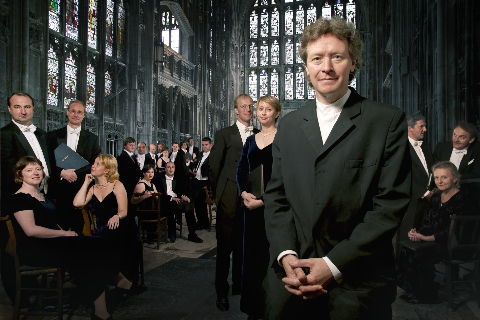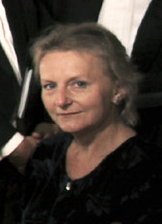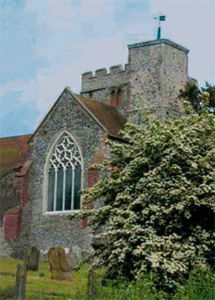|

A Spellbound Audience
The Sixteen at Stour Music,
reviewed by PIPPA HARE and ROSIE EVELEGH
Surely the thirteenth century church of All Saints, Boughton Aluph, nestling among the Wye downs south of Canterbury, must be one of the most fitting places in Southern England in which to hear the The Sixteen perform music of the High Renaissance.

Harry Christophers, with members of The Sixteen, which now also has its own orchestra
|
The scene was perfectly set on this late June evening [27 June 2008] for Harry Christophers and his 'band' of eighteen singers to make their entrance into the church to sing Tudor repertoire as part of their 2008 'Choral Pilgrimage'.
The programme comprised music by Christopher Tye (1505-73), Robert Parsons (1535-72) and Robert White (1538-74). Robert White was the son-in-law of Christopher Tye, and Robert Parsons was White's contemporary.
Parsons' Ave Maria, recognised as one of the outstanding Latin motets of the mid-sixteenth century, opened the evening. As the interesting notes by Sally Dunkley, editor of several of these works, make clear, it would have been sung at the end of the service of Compline. Hence it is a strikingly calm, serene piece, with the soprano line gently descanting over the cantus firmus and weaving middle-voice counterpoint.

Sally Dunkley
|
In this acoustic, the Latin words of Robert White's Lamentations were a little hard to hear, where The Sixteen's usually admirable diction seemed less clear than in the previous work. However the soprano entry in the section 'Heth' (as with Tallis' Lamentations, the sections are prefaced with Hebrew letters) was glorious, like a pinpoint of light in the dark.
In 'Teth', the use of the descending scale helped to accentuate the words, very poignant and full of suffering. 'Iod' was lovely, characterised by clearly defined individual entries ending with the heartfelt 'Jerusalem, Jerusalem'. 'Lamed' built up to a dramatic ending with the words 'quoniam vindemiavit me, ut locutus est Dominus in die irae fuoris sui' ('for the Lord has pressed me like the grape, as he said he would on the day of his furious rage').
Tye's Agnus Dei from his mass 'Euge Bone' ended the first half. Supposedly the Mass was written to celebrate the return from exile of the leading Catholic, Cardinal Pole, in 1554. Compared to the music of White and Parsons it does sounds rather modern.
'Euge Bone', meaning 'Well done good and faithful servant', is a transcendently beautiful setting which showed the Sixteen's men in excellent voice: well blended and confident.
The text of 'O bone Jesu', the second of the Parsons pieces, which followed after the interval, was known as the 'Verses of St Bernard', a compilation of psalm texts, each prefaced by an invocation or acclamation ('O bone Jesu', 'O Adonai', 'O Messias', etc). These texts were frequently included in the Primers known as The Book of Hours, and due to the indisputably Catholic texts they were heavily disapproved of by Archbishop Thomas Cranmer.
Once again the diction, regrettably, was not too clear and 'O Adonai' and 'O Messias' both lacked, one felt, sufficient emphasis. The Parsons piece ended however with the most wonderful 'Amen'.
Robert White's Compline hymn 'Christe qui lux es et dies' uses the pattern of alternating plainchant verses and polyphonic writing, with an emphasis (as often in medieval polyphony) on the tenor part where the cantus firmus -- ie the underlying plainsong melody -- is traditionally located.
It is a more straightforward piece, and despite its Latin provenance quite hymn-like and more akin to Edward VI and Cranmer's simplified English liturgy: in fact an evening prayer asking for peaceful rest. The plainchant here allowed The Sixteen's lower voices to show off to good effect their perfect intonation and phrasing and exquisite delivery, the piece ending with a noble unison doxology.
The final work, Tye's 'Peccavimus cum patribus nostris', is a large-scale motet which opens with the men (here clearly defined and beautiful of tone) and gradually builds in intensity until the first soprano adds her very high notes, which she did effortlessly. (Did the little boy trebles of Tye's and Sheppard's times really sing so high, one wonders?) There is a lovely five-note rising scale which she repeats many times.

All Saints, Boughton Aluph
|
Benefiting from All Saints' refined and reverberant acoustic, the Boughton Aluph audience is one of the most attentive and knowledgeable with regard to Early Music to be found anywhere in the country -- a tribute to the long and glorious tradition established there by Alfred Deller in the early 1960s, and carried on by his son.
A clearly spellbound audience was finally able to show its enthusiasm for what had been a wonderful Kent summer's evening, which in terms of both musical quality and imaginative repertoire made a huge impression on us.
Copyright © 6 October 2008
Pippa Hare and Rosie Evelegh, Kent UK

| 
